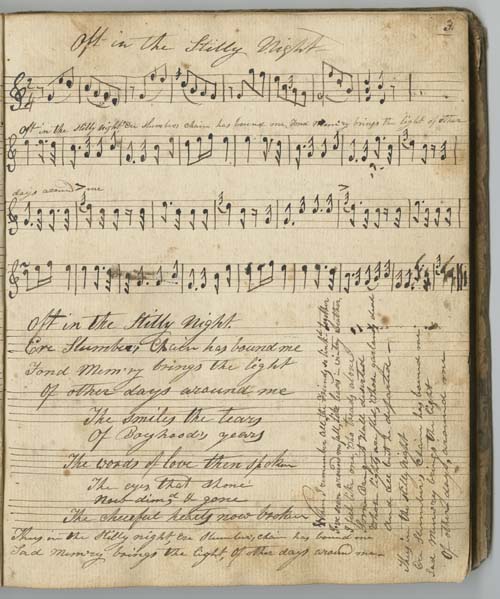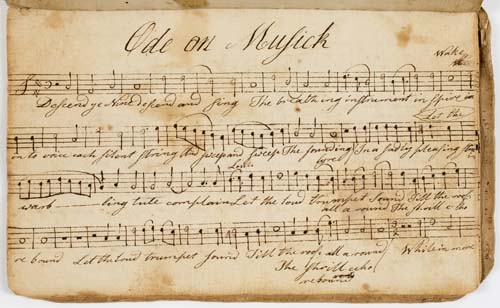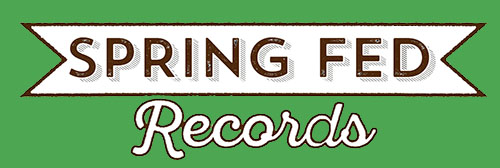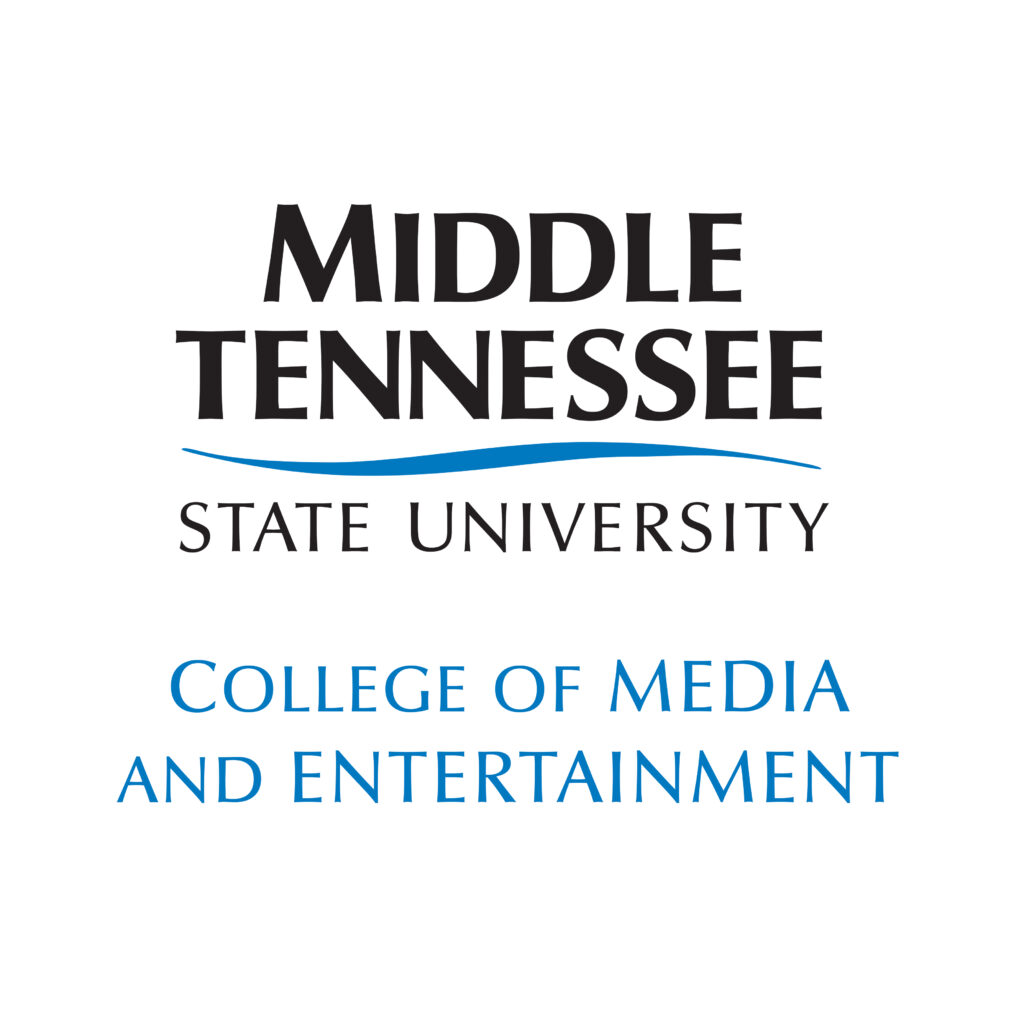Center for Popular Music
American Vernacular Music Manuscripts
ca. 1730-1910: Digital Collections from the American Antiquarian Society and the Center for Popular Music
Search American Vernacular Music Manuscripts Catalog
Handwritten music manuscripts by common Americans contain primary and direct evidence of their musical preferences during a particular time and in a particular place. To see, play from, or study one of these old manuscripts brings us as close to that person’s musical life as history allows. Laborious inscriptions of a tune,hymn, or song – made by musicians of the music they played, loved, or wanted to learn – are precious and unique windows into music-making, acknowledging that this music mattered to them and, thus, matters to us!

“American Vernacular Music Manuscripts, ca. 1730-1910: Digital Collections from the American Antiquarian Society and the Center for Popular Music” has been made possible in part by a major grant from the National Endowment for the Humanities: Exploring the Human Endeavor. Any views, findings, conclusions, or recommendations expressed in this Web resource do not necessarily represent those of the National Endowment for the Humanities.
Additional support has been provided by the American Antiquarian Society, the Center for Popular Music, and Middle Tennessee State University.
Some of these resources may contain offensive language or negative stereotypes. Such materials should be seen in the context of the time period and as a reflection of contemporaneous attitudes. These items are presented here as part of the historical record and do not represent the views of the Center for Popular Music, the American Antiquarian Society, Middle Tennessee State University, or the National Endowment for the Humanities.
The American Vernacular Music Manuscripts Project
The period covered by this project found Americans across a wide range of classes, occupations, and regions learning to read and notate music. Ordinary citizens bought copybooks (often pre-ruled with musical staves) or fashioned their own and then inscribed in them the songs, hymns, and tunes that mattered to them, music they had composed, performed, heard, or wanted to learn. Their work has come down to us as prima facie evidence of musical lives desired or lived.
In order to give example to the supposition, consider the following descriptions of two such manuscripts along with some of the questions they pose.
Probably in the spring of 1872, I. Roth of Jonestown, Pennsylvania bought a small, leather-bound, staff-ruled copybook, manufactured by Engel Brothers of 750 Penn Street in Reading, Pennsylvania, about thirty-five miles from Roth’s home. On the 23rd of May, 1872, he used blue ink and inscribed his name on the title page in gothic lettering. Roth was (probably) a semi-professional musician who played in a local wind band that featured marches, polkas, quicksteps, and popular songs in its repertoire. Into his book Roth copied sixty tunes, all of which he numbered; some of them have titles that suggest local origins, such as the “Jonestown Quickstep” and the “Lehigh Quickstep.” The smudges at the bottoms of the pages near the binding, where the pages would have been held open, suggest good use was made of the book. Sometime in 1875, William Koehler, also of Jonestown (and a band mate of Roth?), came to own the book. The ink that Koehler used has since faded to a light brown, showing us when he started entering tunes (at #61—”Dead March”); he went on to add thirty-eight more tunes to the book, not all of which are as systematically numbered as Roth’s entries. Koehler also realized that some clever calligraphy could modify the gothic “I. Roth” to an equally gothic “W. Koehler,” and he thus re-branded the book. See this manuscript here: MUMSS-0013
As much as this books tells us, it leaves yet more unsaid. In which band did Roth/Koehler play? Who was their audience? For what events? How far from Jonestown did they play? How often? Did they get paid for playing? How much of their families’ income depended upon music-making? If they were of German heritage, why is the repertoire so “American?”
The Battle of Fredericksburg was fought between the 11th and 15th of December, 1862. Family lore has it that Charles Stewart commemorated that battle by fashioning a small (64mm x 201mm) one-page folder. The front cover features two American flags, both clipped from newspapers and pasted to the leaf along with trains and some sort of emblematic symbols. The inside of the folder holds more pasted snippets—”UNION,” flags, an elephant—and an inscription: “Dec. 14th – Fredericksburg – 1862.” Sewn into the folder is a single piece of ruled paper onto which the elegy “Hark! The Cry of Death is Ringing” is written in ink, with the instruction that it be sung “In chanting Style.” It is dated “Jany. 1st AD 1863.” On the back of the page is the text to the hymn, filled with the imagery of death. Barely discernible at the bottom of the page is “Luzerne Township Fayette County Pa.” See this manuscript at: MUMSS-00133
Why is the tune written in a seven-shape note system, generally considered a southern tradition? Since none of the ready databases seem to hold a hymn with this title, is this an original, unpublished composition, written to express one ordinary person’s horror at the carnage in Fredericksburg? The subtitle is “Quartette”; are there three other parts somewhere? Why the time and care put into fashioning the folder? For what purpose?
Research on such music and music-making, expressive of common Americans, has been central to American music studies for the last half century. The work has not been without its problems, however, for even so basic a question as what to call the music had to be addressed. In 1969, H. Wiley Hitchcock published his Music in the United States: A Historical Introduction, in which he treated two important currents in American music, one the “cultivated” (generally “classical music”) and the other he termed the “vernacular”—a music “plebeian, native, not approached self-consciously but simply grown into as one grows into one’s vernacular tone.”1 Folklorist Archie Green, in an article on the word “vernacular” and its applicability to American music, spoke of the dynamic setting “for musical change that underscores the continuous fluidity in definitions of vernacular music. Literally, our term cannot stand still; it runs constantly trying to touch fresh sounds, novel configurations of old musics, and creators born with the morning dew.”2 “Vernacular music,” thusly, seems to have arrived—a term connoting the music that lies closest to the heart of the American democratic experience, as American vernacular music manuscripts give boldest evidence of how musicians expressed that experience.
Counted together there are many hundreds of vernacular manuscripts extant, and probably thousands. Indeed, scholar Kate Van Winkle Keller has located more than 450 of them, and those are only of secular music before 1820.3 Scores of libraries, archives, repositories, and historical societies hold them, institutions that range from the Library of Congress, which has an impressive cache of such manuscripts, to the smallest historical society, which might hold only a single page bound in the back of an old volume.4 All have a common problem: How do they catalog the manuscripts so that bibliographic information is systematic and accurate, while making public access easy and convenient? In truth, relatively few such institutions have librarians or catalogers trained in music materials and even fewer know what to do with vernacular music manuscripts. Many of these interesting and important documents thus remain hidden in the far corners of the archives, sketchily cataloged (if at all), and not easily available to scholars, students, or interested music-lovers.
Meanwhile, scholarly interest in American music is bounding ahead, with new research resources fueling much of the energy. Before the publication of the National Tune Index in 1980 and the Hymn Tune Index (in 1998) there was no convenient, reliable way to access databases of detailed information on vernacular music in early America. Now that these resources (and some few others, such as The Dictionary of North American Hymnology) have migrated to the Internet, researchers use and rely upon them daily.5 Yet the Hymn Tune Index does not treat manuscripts at all, and although Early American Secular Music and Its European Sources inventories 145 American manuscripts, none is of sacred music and none later than 1839. Since there was obviously much work to be done, this project was born to provide a bold start and partial redress.
The Institutions and Their Collections
Among the largest and most significant vernacular music manuscript holdings in the nation are those of the American Antiquarian Society and the Center for Popular Music.
The American Antiquarian Society (AAS; www.americanantiquarian.org) is a learned society and independent research library founded in 1812 by Isaiah Thomas, a patriot leader during the American Revolution and the foremost printer, publisher, and bookseller in the United States following Benjamin Franklin’s retirement from the trade. AAS is the third oldest historical society in the country and the first to support scholarly activities on a national level. The Society maintains a research library and archive containing material relating to all aspects of American life from first contact through the year 1876. Books and pamphlets number approximately 750,000 volumes and include, in addition to the early printed material, selected modern secondary works, a full array of bibliographical tools, academic journals, and other aids to research. The collection of pre-1877 American newspapers—the best anywhere in the world—amounts to more than two million issues. AAS also has an exceptionally strong collection of early American graphic arts materials. The Society’s collections serve a worldwide community of scholars, teachers, historians, bibliographers, students, and authors whose research directly affects the quality of humanistic knowledge and education. With such rich library resources as a base, the Society has devoted much energy to the listing, cataloging, and study of the material in its care in the context of American history and culture. Founder Isaiah Thomas himself wrote the first history of printing in America (1810) and compiled some of the earliest bibliographies. Many of the standard bibliographies of American imprints were compiled largely at AAS or were published by the Society. The Society has always placed a high premium on cataloging efforts to make all American printed materials fully available to scholars and to other libraries.

The Center for Popular Music (CPM; popmusic.mtsu.edu) at Middle Tennessee State University (MTSU) in Murfreesboro was established in 1985 as a designated “Tennessee Center of Excellence.” Its mission is to promote research on American vernacular music, and to foster an understanding of the nation’s diverse musical culture and its global reach. Towards such, the Center: manages and provides public access to a research archive and library; presents public programs; develops research projects; disseminates scholarship through various media; maintains a state-of-the-art recorded media preservation laboratory; and sustains the educational mission of MTSU. The Center has built a large and impressive archive that spans from the early eighteenth century to the present. More than one million items are held in its collections, including: sheet music (110,000 pieces), sound recordings (200,000), trade catalogs, songsters (1,600), broadsides (3,500), photographs (11,000), dance/theater band orchestrations (3,500), gospel songbooks (2,500), posters, playbills, concert programs, periodicals (2,200 titles), and more than 300 archival collections of personal papers, scrapbooks, and unique unpublished sound recordings. The Reading Room Library holds 12,000 books and scores that support research in all aspects of vernacular music. CPM is unique among vernacular music research centers in its breadth of approach, which is not delimited by genre, style, or chronology, and notable for the depth of collections. The Center’s collections are stored in a temperature- and humidity-controlled environment, and maintained by a full-time staff of seven, supplemented during semesters by two graduate assistants. It is open for research year-round and has been used, in person, by scholars from more than thirty countries and all of the states of the nation.
AAS has long valued American manuscripts, both with and (much more commonly) without music. Manuscript holdings number more than 1,500 collections and more than one million items, spanning the years 1613-1930. While the Society collects printed material on a national level, manuscripts are collected more selectively, with a focus on New England. Altogether, AAS holdings number more than 215 volumes of manuscript music, dated ca. 1730-ca. 1870, plus three boxes of loose music manuscripts. More than a dozen of the bound volumes are cataloged under the owner’s name, but the bulk of the music is in two collections: the Music Book Collection (21 volumes and 2 boxes) and the Irving Lowens Collection (53 volumes).
The CPM’s collections policy early recognized the importance of music manuscripts that were American or that bore upon the American musical experience. Special acquisition efforts were made in that area and the Center now holds more than 150 music manuscripts in its collection. The CPM collection generally contains fiddle/fife/flute dance tunes, hymns, songs, ballads, and few other instrumental pieces. The manuscripts that date from ca. 1775-1910 (the period covered by this project) number more than 125. Included among these are commonplace books, copybooks, and single and double leaves. Pages in individual items range from one to 384, with more than 4,000 inscribed pages and nearly 5,000 musical pieces. Almost all the manuscripts are of American provenance, although a few originated in England, Scotland, Ireland, or France.
History of the Project
In July, 2012, a grant proposal from the Center for Popular was submitted to the National Endowment for the Humanities (http://www.neh.gov), under the “Humanities Collections and Reference Resources” program. The proposal was for a collaborative project between the Center for Popular Music and American Antiquarian Society to:
- survey and conserve their vernacular music manuscript collections;
- digitize them to archival standards;
- describe them bibliographically;
- inventory all contents at the song-title level;
- create and share MARC bibliographic records;
- store PDF virtualizations of all manuscripts at Internet Archive;
- and build and maintain the “American Vernacular Music Manuscripts Website” (AVMM) to provide web-based public access to all information and contents.
The project was to treat manuscripts that are American in provenance (or that touch directly upon the American musical experience) with contents that are preponderantly vernacular in style. It covered manuscripts dated from ca. 1730 (the earliest in the AAS collection) to 1910, a time when recordings started to serve a didactic function for musicians somewhat like the role notation played in earlier days and when vernacular music publications became more readily available.
The collections of AAS and CPM complement each other, hence the collaborative aspect of the proposal. While both have rich holdings in sacred and secular music, the AAS is generally stronger in sacred music manuscripts and the CPM in secular music manuscripts. AAS manuscripts tend to be older than those in the CPM, whose collection better covers a period in which American musical life was especially vital and dynamic but is yet under-studied and under-appreciated by scholars. Between the two collections, chronological periods of American music-making were well represented. The institutions also complemented each other, for while the AAS is a venerable, privately endowed archive and library more than two hundred years old, with wide and deep holdings across the range of American history, the CPM is a publicly funded archive and library only a few decades old that is tightly focused on building and maintaining holdings in American vernacular music.
The project proposed to go well beyond what has been done before with vernacular music manuscripts in many aspects, and to offer critical enhancements of practices in others. Most obviously, instead of surveying a wide field of institutions with holdings (as was done in Keller, Popular Secular Music, for example6), or inventorying select music manuscripts (as in Fuld and Davidson, 18th-Century American Secular Music Manuscripts7), the proposal called for creating fully descriptive catalog records that adhere to MARC (Machine Readable Cataloging) formatting standards, with attendant content (i.e., “song-level”) inventorying, of two rich, complementary collections that together total more than 350 manuscripts. At its completion, the project would provide easy, convenient public access to full digital images of all music and manuscript pages.
In March, 2013, word arrived from the NEH that the project had been fully (and enthusiastically!) funded. In September of that year, work began and continued through November 2014, when the AVMM website was launched and a completion report was filed with the NEH.
Uses of the AVMM Website
Scholars, students, and those with general interests may use the AVMM website in manifold ways. An obvious question to ask of the manuscripts is, “Why did the music matter enough to common people that they invested time and energy in writing it down?” Of course, no answer is likely to be conclusive on that score, but evidence supported by a database containing more than 10,000 pieces of music will be substantial. Since a search of the AVMM yields data that can be organized in many different ways, scholars can learn about music-making in a place or region, during a particular period, in a particular style or genre, that employs particular musical forces, that adopts a specific notational scheme (shape note; round note; etc.), by gender, ethnicity, class, occupation, age, or any combinations of these and much more. Evidence on the history of the book and on book-making may also be discovered; for example, how relatively common were ledger-lined copybooks, or how prevalent were commonplace books for notating music, or how frequent are holographic oblong music book formats utilized. Since many of the books are identified by name or names social histories that hinge on music-making (itself a primary means of identity expression) beg to be written. (E.g., “Marcia Goodman’s Property, Hartford, February 7th, 1812/Not William Goodman’s Book, Hartford, but Marcia M. Goodmans, 1814”; see at: https://archive.org/details/MarciaMGoodmanBook)
Users should find the keyword search capability in the AVMM of particular use. Song/tune/hymn histories have long been of special interest to musicologists, hymnologists, and folklorists who want to know when melodies first appeared; where they were used; by whom they were performed; for what function; in what form; how popular were they; and how did they change over time? Take “Yankee Doodle,” for example: When does it show up in music manuscripts? Where? How often? And when does the “flatted-seventh B strain” of the tune fall out of favor in holographic manuscripts (which are more likely to record direct practice than do publications)? It is also likely that a good number of titles inventoried here will turn out to have preceded publication or collection of any other kind. Some inscribed melodies and pieces captured by this project might never have been published at all, thus preserving a unique record.
And then there is the beauty and joy of working with high-quality digital images from any place in the world. Anyone is now able to examine the music in full detail and in context, for searches of the AVMM will automatically direct the user to images stored on the Internet Archive, where the page-turn technology replicates some of the sensory joys of working with old, often fragile, manuscripts, but allows for their full preservation.
Citation Guidelines
For citing materials from the Center for Popular Music, the preferred citation format is:
From the Music Manuscripts Collection, Center for Popular Music, Middle Tennessee State University.
For citing materials from the American Antiquarian Society, the preferred citation format is:
American Antiquarian Society, Worcester, Mass.
Guidelines for Cataloging American Vernacular Music Manuscripts to MARC Formatting Standards
Click here to download the Guidlines as a PDF.
Reproduction and Copyright Policies
For the Center for Popular Music
Reproductions will be provided only upon receipt of a signed Reproduction Request Form and prepayment. The form covers both provisions for “Fair Use” of materials under copyright and the Center’s own requirements for citations and acknowledgement. Rush orders are accepted at the discretion of the Center and may be subject to additional charges. The Center reserves the right to limit the total number of copies it will provide. For large orders or multiple requests, an hourly research fee may apply. For more information: Center for Popular Music Reproduction Policy
The Center limits copying and reproduction services to those permitted under current copyright regulations. The Copyright Law of the United States (Title 17, sections 107 and 108) governs the making of photocopies or other reproductions of copyrighted material. It is the responsibility of the researcher to know and comply with all copyright restrictions.
For the American Antiquarian Society
The American Antiquarian Society offers reproduction services as an aid to scholarly research in accordance with its mission to provide access to materials while preserving them for the use of future generations. All requests for digital scans must be submitted in writing and are subject to the approval of the Society.
For reproduction and use requests visit: https://www.americanantiquarian.org/collections/obtaining-digital-images-rights-and-reproductions
Project Staff
Co-Directors
- Dale Cockrell (CPM)
- Thomas Knoles (AAS)
Cataloging Assistants
- John Fabke (CPM)
- Rachel Morris (CPM)
Librarians
- Grover Baker (CPM)
- Drew Beisswenger (CPM)
Administration Assistants
- Yvonne Elliott (CPM)
- Rose Johnson (MTSU)
Information Technologies
- Dustin Hampton (MTSU)
Digital Photographer
- Cade Overton (AAS)
Assistant/Cataloger
- Lindsay Million (CPM)
Archivist
- Lucinda Cockrell (CPM)
Quality Control
- Olivia Beaudry (CPM)
- Truman Lusson (CPM)
Database/Website Consultants
- Ann Stringfield (InfoCrofters)
- Jonathan Jacobson (Andornot Consulting)
Consultants
- Babette Gehnrich (German)
- Dieter & Magdalene Hain (German)
- Kate Van Winkle Keller (Music)
- Peter Moore (German)
- Hildgund Schaefer (German)
- Jonathan Trundle (Digital Imaging; MTSU)
- Paul F. Wells (Music)
Acknowledgment
A special note of gratitude and appreciation for the generous support provided by the James E. Walker Library, Dean Bonnie Allen, and the Digital Scholarship Laboratory at Middle Tennessee State University.
1. Third edition (Englewood Cliffs, N.J.: Prentice Hall, 1988), 54.
2. Archie Green, “Vernacular Music: A Naming Compass,” Musical Quarterly 77/1 (Spring 1993), 44.
3. Kate Van Winkle Keller, email correspondence to Dale Cockrell, 6 February 2012.
4. Cf., there are seventy-four such American manuscript collections listed in Kate Van Winkle Keller, Popular Secular Music in America through 1800: A Preliminary Checklist of Manuscripts in North American Collections, MLA Index & Bibliography Series, number 21 (Philadelphia: Music Library Association, 1981).
5. Kate Van Winkle Keller and Carolyn Rabson, compilers, The National Tune Index: 18th-Century Secular Music (New York: University Music Editions, 1980); this database has since been incorporated into the online Early American Secular Music and Its European Sources, 1589–1839: An Index (Annapolis, Maryland: The Colonial Music Institute, 2002) compiled by Robert M. Keller, Raoul F. Camus, Kate Van Winkle Keller, and Susan Cifaldi; see at http://www.colonialdancing.org/Easmes/. Nicholas Temperley, The Hymn Tune Index: A Census of English-Language Hymn Tunes in Printed Sources from 1535 to 1820, assisted by Charles G. Manns and Joseph Herl (Oxford: Clarendon Press; New York: Oxford University Press, 1998). The Dictionary, which originally treated only hymn texts, has now been folded into Hymnary.org and a “melody search” capability added; see at http://www.hymnary.org.
6. Which describes twenty-two AAS manuscripts, none of which are inventoried at the song-title level.
7. Which describes and provides song inventories of twelve AAS manuscripts.
Contact Us
Center for Popular Music
Bragg Media & Entertainment Bldg.
Room 140
MTSU Box 41
1301 E. Main Street
Middle Tennessee State University
Murfreesboro, TN 37132
615-898-2449




